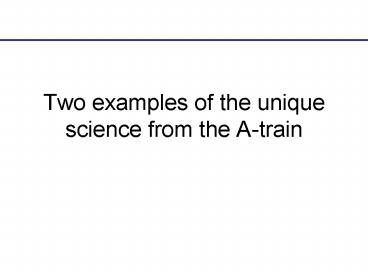Two examples of the unique science from the Atrain PowerPoint PPT Presentation
1 / 14
Title: Two examples of the unique science from the Atrain
1
Two examples of the unique science from the
A-train
2
1. Hurricanes
Three unique pieces of information that are only
available from the A-Train are used to provide
new insights on hurricane intensity 1. CloudSat
provides a direct measure of the altitude of
clouds as part of hurricanes (ztop) 2. MODIS
provides a measure of the emission temperature
from tops of clouds (T0) 3. CloudSat provides a
view of the internal structures of convection in
hurricanes - identifies undilute convective
cores These three pieces of information are
combined to provide new, physically based
estimates of low-level wind speed. Emanuel theory
predicts Vmax f(ztop, T0,SST) This is the
first theory-based approach for determining storm
intensity from satellites (paper attached)
3
- Hurricanes (continued)
- Example of A-train data
MODIS 11um brightness temperature
Eye of hurricane
4
- Hurricanes (continued)
- Using the data to determine intensity
ClodsatMODIS data
5
2. Making warm rain
The issue - one of the longstanding, unresolved
questions in atmospheric sciences is why does it
rain as rapidly as observed in nature. Theory has
not been able to answer this baqsic
question. Why this is important - the warm rain
process is elementary to many of the key climate
issues related to the hydrological cycle,
elementary to the problem of effects of pollution
on rain, and central to understanding of
essential cloud-climate feedbacks. Prior to the
A-Train we were only able to study the warm rain
production processes in the laboratory or as part
of limited area field experiments. Thus we have
not been able to probe issues associated with
large-scale environmental influences (like
aerosol) on rain production.
6
The coalescence process - falling drops grow
through collisions with smaller drops
- The idea - we can estimate the rate at which
cloud water is converted to rain on the global
scale and identify important factors that
influence this conversion process. - MODIS provides information on the cloud water,
- Cloudsat reflectivity information provides a way
of discriminating he incipient stages of
precipitation formation - For these cases, CloudSat radar provides a view
of the the precipitation drops. - Combined, these observations provide a direct
measure of the rate at which precipitation water
is created.
CloudSat radar is largely sensitive to these
collector drops
MODIS is largely sensitive to small drops
7
A global view of coalescence
This figure shows the first large-scale estimate
of coalescence (y axis) of cloud water (x axis) -
the time scale implied is a critical parameter
for representing this process in models
Stephens and Haynes, 2007
8
3. Optimizing NASAs EO resources CloudSat and
the A-Train - solved a long-standing paradox
differences in cloud-top heights
MODIS sensitive to cloud-top (not appropriate
for UV-VIS trace-gas retrievals)
OMI effective cloud pressure from Raman
scattering UV/visible light penetrates deeper
One A-train example What do clouds look like to
OMI, MODIS and Cloudsat? (Important question for
trace-gas retrievals)
9
Radar/Lidar Combined Product Development
- Formation flying is a key design element in
cloudsat - CloudSat has demonstrated formation flying as a
practical observing strategy for EO. - Overlap of the CloudSat footprint and the CALIPSO
footprint, within 15 seconds, is achieved gt90 of
the time.
10
lidar/radar combined ice microphysics - new
A-Train ice cloud microphysics
Preliminary example from Zhien
11
A-train Cloud ice
MLS
ECMWF
CloudSat
12
Comparison to MLS that employs entirely different
physics gives much insight on sensitivity and
characteristics of both products Statistically,
cloudsat and MLS closely agree.
Wu et al., 2007
13
A case study example of comparison between
CloudSat and AMSRE - passive microwave methods
are missing significant fractions of light
precipitation - this exposes issue with
precipitation algorithms
The portion of orbit highlighted by red is where
Cloudsat determines precipitation to have
occurred. AMSRE considers preciptation to occur
only when the cloud liquid water reaches some
(arbitrary and untested) threshold)
14
2. Comparison of precip frequency
PIA-based precip
There are major differences in the two
precipitation estimates that are just now
beginning to be understood

